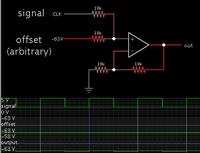jeffwjz
Junior Member level 1
Hello,
I am now trying to shift a voltage by adding an offset. For example, a voltage relative to ground is 5V and now I wish to offset this voltage by, say -30V. Therefore the shifted voltage now is -25V relative to ground. The key to this design is that the original voltage level is fixed = 5V while the voltage offset can vary.
Are there any possible ways that can let me achieve this? I don't think I can use an op-amp since normally the op-amp output range is limited to 15V.
Please help.
Thanks.
Jingzhe
I am now trying to shift a voltage by adding an offset. For example, a voltage relative to ground is 5V and now I wish to offset this voltage by, say -30V. Therefore the shifted voltage now is -25V relative to ground. The key to this design is that the original voltage level is fixed = 5V while the voltage offset can vary.
Are there any possible ways that can let me achieve this? I don't think I can use an op-amp since normally the op-amp output range is limited to 15V.
Please help.
Thanks.
Jingzhe
